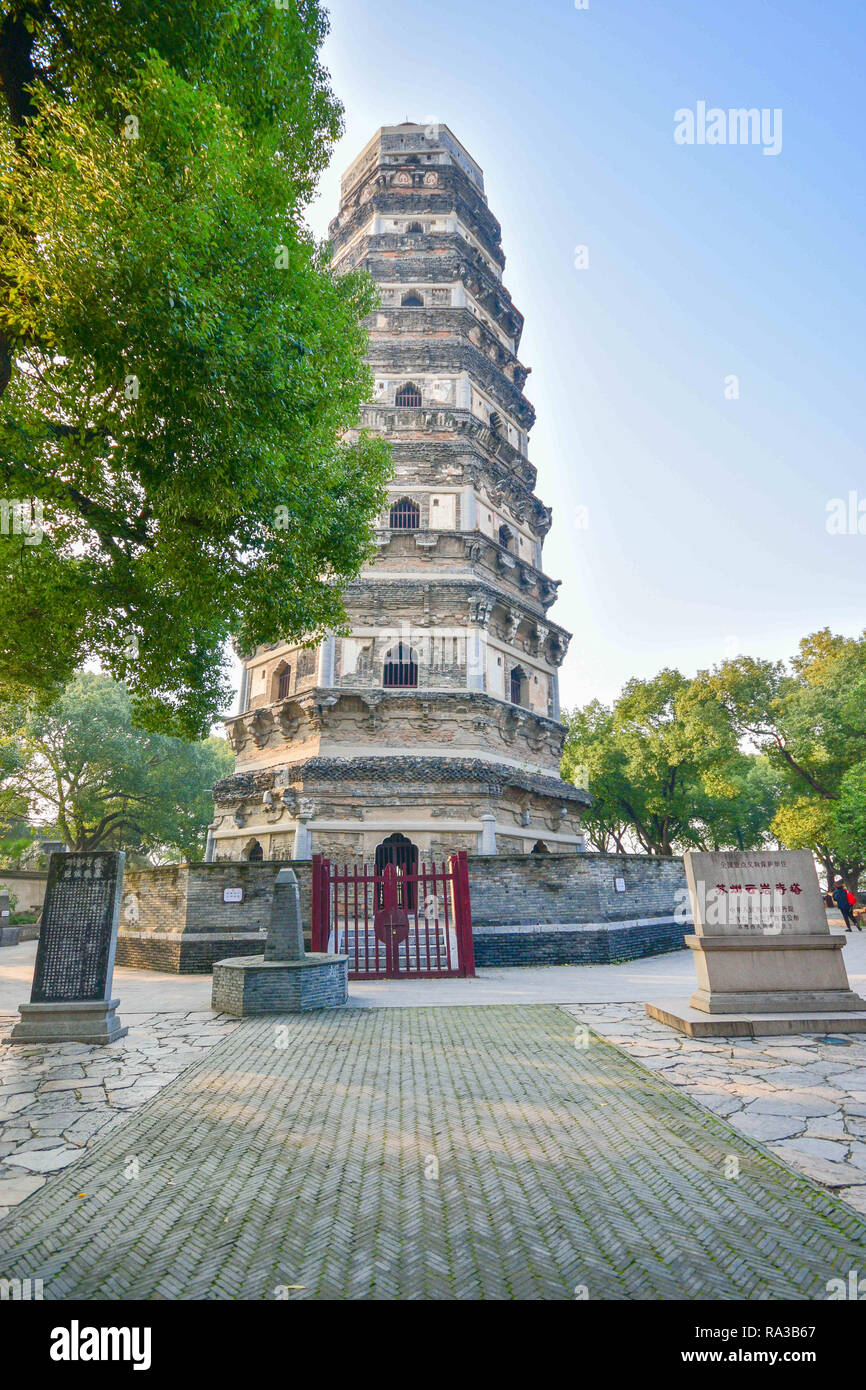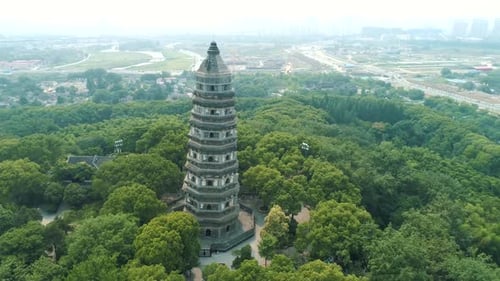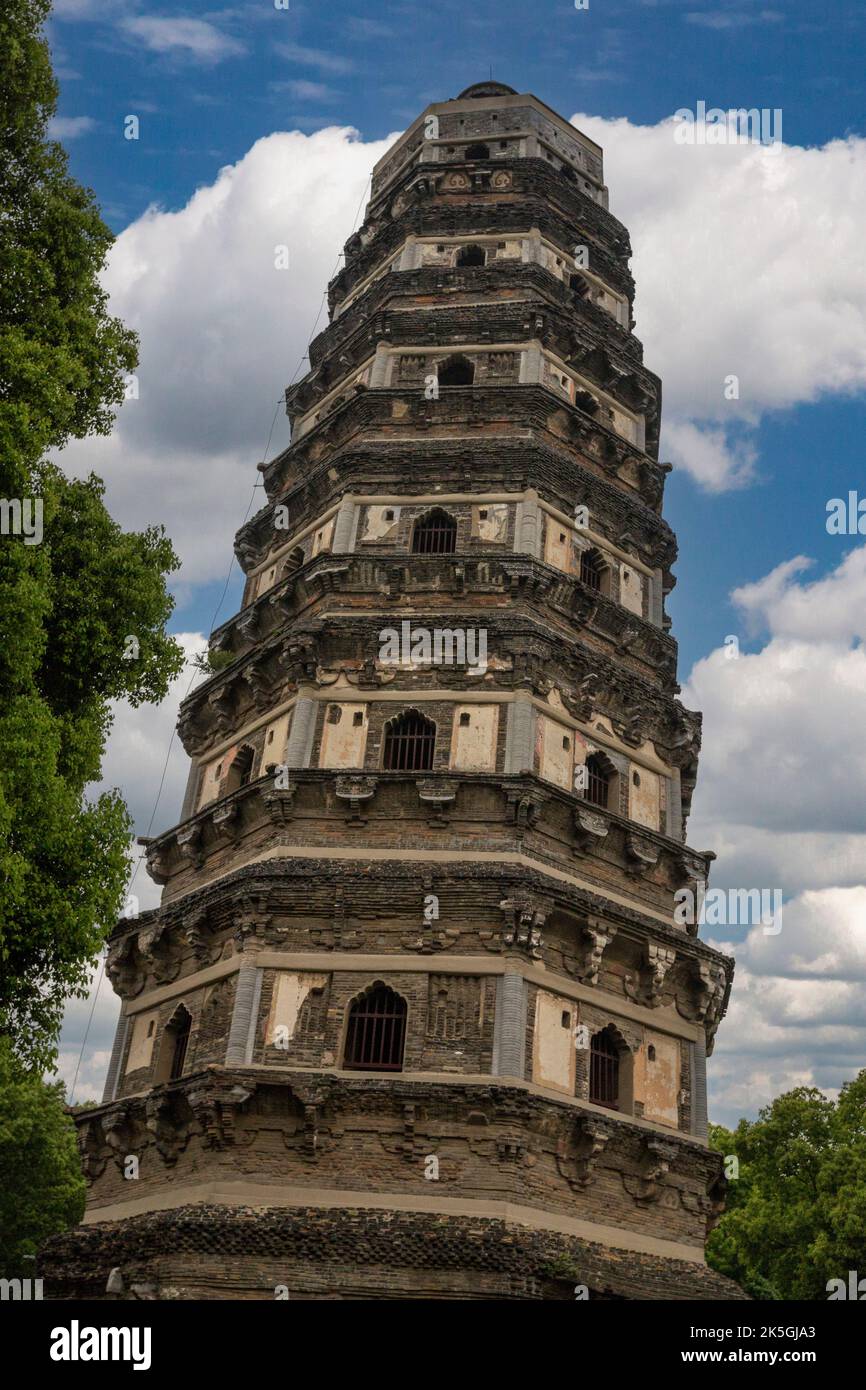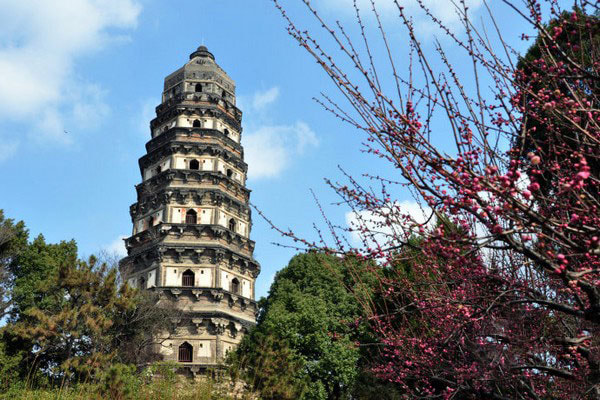Why Yunyan Pagoda is a Must-See Destination for Culture and Nature Lovers

An Essential Guide to Visiting Yunyan Pagoda
Nestled within the picturesque landscapes of Suzhou, the Yunyan Pagoda—also known as the Cloud Rock Leaning Pagoda—stands as a testament to ancient architectural prowess and cultural significance. What sets this pagoda apart is its intriguing 5% lean, which has captivated visitors for centuries, making it an iconic feature of the Tiger Hill area. As you approach this remarkable structure, framed by lush bamboo forests and serene ponds, you’ll find yourself enveloped in a rich tapestry of history and natural beauty.
In this guide, we’ll delve into everything you need to know for an unforgettable visit to Yunyan Pagoda. From practical tips on ticket prices and the best times to visit, to insights on the surrounding attractions and recommendations for enjoying the scenic walks that lead to the pagoda, we aim to equip you with all the essential information. Whether you’re a history buff, a photography enthusiast, or simply someone seeking a tranquil escape, this guide will help you make the most of your journey to this architectural marvel.
In This Guide
- An Essential Guide to Visiting Yunyan Pagoda
- The Rich History and Legends of Yunyan Pagoda
- Main Highlights: What You Absolutely Can’t Miss
- Planning Your Visit: A Practical Guide
- Tickets: Prices, Booking, and Tips
- How to Get There: A Complete Transportation Guide
- Local Cuisine and Accommodation Nearby
- Frequently Asked Questions
- Final Thoughts on Your Trip
The Rich History and Legends of Yunyan Pagoda
A Journey Through Time: The Story of Yunyan Pagoda
Nestled on the picturesque Tiger Hill in Suzhou, the Yunyan Pagoda, also known as the Cloud Rock Leaning Pagoda, is a remarkable testament to Chinese architecture and spirituality. Its long history, steeped in legends, makes it a must-visit destination for travelers seeking to immerse themselves in the rich cultural tapestry of China.
The Origins of Yunyan Pagoda
Constructed during the late 10th century, the Yunyan Pagoda was built in 961 AD during the Five Dynasties and Ten Kingdoms period. Originally serving as a critical structure for the nearby Huqiu Temple, its design reflects the exquisite craftsmanship of the period. Standing at just over 30 meters, the pagoda is notable for its distinct lean, which has earned it the nickname “Leaning Tower of China.” As you approach it, the sight of the pagoda, slightly tilting against the backdrop of lush greenery, is breathtaking and emblematic of the resilience of history.
Architectural Marvel
The pagoda showcases a unique octagonal structure with seven stories, each adorned with intricate brick carvings and exquisite eaves that extend gracefully outward. The architectural style represents the Buddhist influence of the time, blending functionality with spiritual significance. The lean of the pagoda, approximately 5 degrees off vertical, adds to its allure, as it has survived centuries of natural erosion and remains a remarkable feat of engineering.
Legends Surrounding the Pagoda
Yunyan Pagoda is not just an architectural marvel; it is also steeped in folklore. One of the most famous legends tells of a monk named Xuanzang who, while traveling to India to retrieve sacred Buddhist texts, stopped at the pagoda to pray for guidance. It is said that a divine light illuminated the pagoda, guiding him on his journey and ensuring his safe return. This legend resonates with visitors, adding an element of mystique to the site.
Another tale involves the pagoda’s construction. According to local lore, the pagoda was built with the help of a dragon that resided in the nearby waters. The dragon, seeing the monks’ dedication to their craft, decided to lend its strength, helping to erect the structure that would become a symbol of faith for future generations.
A Cultural Icon
Over the centuries, Yunyan Pagoda has become a cultural icon, attracting pilgrims and tourists alike. During the Song Dynasty, it was a prominent stop for travelers along the Silk Road, further enhancing its status as a site of both pilgrimage and tourism. Today, it stands as a centerpiece of the Tiger Hill scenic area, surrounded by serene ponds, ancient trees, and walking paths that invite exploration and contemplation.
Modern-Day Significance
In contemporary times, the Yunyan Pagoda continues to hold a significant place in the hearts of the people of Suzhou and beyond. It has been recognized as a key historical site in China, preserving not only the architectural brilliance of the past but also the spiritual heritage that it embodies. Visitors are often drawn to the pagoda for its historical significance, picturesque setting, and the legends that breathe life into its stones.
Conclusion
Visiting the Yunyan Pagoda offers a unique opportunity to step back in time and experience a slice of China’s rich history. With its fascinating stories, architectural beauty, and spiritual significance, it remains a testament to the enduring legacy of Chinese culture. Whether you are a history buff, a spiritual seeker, or simply a curious traveler, the Yunyan Pagoda promises an unforgettable journey through the annals of time.

Yunyan Pagoda.
Main Highlights: What You Absolutely Can’t Miss
1. The Leaning Marvel
The Cloud Rock Leaning Pagoda, known locally as Yunyan Ta, is the star attraction of Tiger Hill and a must-see architectural wonder. Leaning at a precarious angle of about 5%, this ancient structure dates back to the year 961 AD, making it a remarkable testament to the ingenuity of ancient builders. The pagoda rises majestically above the surrounding landscape, enticing visitors with its striking silhouette against the sky.
Practical Tips: Make sure to bring your camera; the views from the base and the climb upwards offer stunning photo opportunities. Visiting during early morning or late afternoon will provide the best lighting for your shots.
2. Scenic Climb
The ascent to the pagoda is facilitated by a series of ancient stone steps, which offer both a physical challenge and a glimpse into the historical significance of the site. As you climb, take a moment to appreciate the intricate carvings and inscriptions that adorn the steps, telling tales of the pagoda’s storied past.
Practical Tips: Wear comfortable shoes, as the stone steps can be uneven and slippery, especially during the rainy season. Hydrate well before your climb, and take your time to enjoy the views that unfold around you.
3. The Enchanting Bamboo Forest
As you make your way to the pagoda, you’ll encounter a serene bamboo forest that offers a peaceful respite from the hustle and bustle of the surrounding areas. The gentle rustle of bamboo leaves cascading in the breeze creates a tranquil atmosphere that is perfect for unwinding.
Practical Tips: Take a moment to sit and relax in this tranquil setting, perhaps indulging in a light snack. Don’t forget to capture the ethereal beauty of the bamboo, especially if the sunlight filters through the leaves.
4. Buddhist Temple
Adjacent to the pagoda, the ancient Buddhist temple adds a spiritual dimension to your visit. The temple, with its intricate architecture and serene atmosphere, invites you to explore its halls, adorned with statues and carvings that reflect centuries of devotion.
Practical Tips: Be respectful while exploring the temple grounds. Photography may be restricted in certain areas, so observe any posted signs. If possible, join a local guide to gain deeper insights into the temple’s history and significance.
5. Outdoor Movie Area
For a unique twist, the site features an outdoor movie area where visitors can enjoy classic films surrounded by nature. This unexpected entertainment option allows you to unwind after a day of exploration, offering a delightful blend of culture and leisure.
Practical Tips: Check the schedule for movie screenings in advance and arrive early to grab a good spot. Bring a blanket or cushion for added comfort, as seating can be limited.
6. The Bonsai Garden
Take a leisurely stroll through the adjoining bonsai garden, where you can marvel at meticulously crafted miniature trees that showcase the artistry and patience of skilled bonsai cultivators. This garden is a feast for the senses and provides a perfect backdrop for reflection.
Practical Tips: Plan to spend at least 30 minutes wandering through the garden. It’s a great place for quiet contemplation or simply enjoying the beauty of nature. Consider visiting during bloom seasons for the most vibrant displays.
7. Nearby Walking Paths and Ponds
The area surrounding the Yunyan Pagoda is adorned with picturesque walking paths and serene ponds, making it an ideal location for a leisurely stroll. These paths offer beautiful views of the pagoda from different angles and allow you to immerse yourself in the natural beauty of Suzhou.
Practical Tips: Allocate some time for a leisurely walk, particularly near the ponds where you can spot koi fish and enjoy the serene ambiance. Bring along a picnic to fully embrace the tranquility of this picturesque setting.
Exploring Yunyan Pagoda promises a blend of history, culture, and natural beauty that captivates all who visit. Don’t miss out on any of these highlights to make the most of your experience!

Yunyan Pagoda.
Planning Your Visit: A Practical Guide
Best Time to Visit
The ideal time to visit Yunyan Pagoda, also known as the Cloud Rock Leaning Pagoda, is during the spring and autumn months (April to June and September to November). During these periods, the weather is typically mild and pleasant, making it perfect for exploring the site and the surrounding gardens. Be mindful that the peak tourist season runs from April to October, when ticket prices are higher—70 RMB during peak months and 60 RMB for the rest of the year. Early mornings or late afternoons during weekdays are recommended for a quieter experience.
Recommended Itinerary
When planning your visit, consider the following itinerary to fully appreciate Yunyan Pagoda and its surroundings:
-
Arrival and Exploration: Begin your day early at Tiger Hill. Wander through the scenic paths leading up to the pagoda, taking in the lush greenery and historic structures along the way.
-
Visit the Pagoda: Spend time exploring the pagoda itself. Its unique leaning structure and intricate architecture are best appreciated up close.
-
Temple Visit: After visiting the pagoda, take a moment to explore the nearby Buddhist temple, which adds a spiritual dimension to your trip.
-
Snack Break: Enjoy some local snacks available at the outdoor movie area near the pagoda. This is a great way to recharge before continuing your exploration.
-
Stroll Through the Gardens: Don’t miss the beautiful bonsai tree garden and serene ponds in the area. The walking paths are perfect for a leisurely stroll.
-
Photography Session: As the sun begins to set, capture the pagoda in the golden hour light for stunning photographs.
Photography Tips
- Golden Hour: The best time for photography is during the golden hour—early morning or late afternoon—when the light is soft and warm.
- Composition: Utilize the pagoda’s unique leaning angle to create interesting perspectives. Capture it from various angles, including the base, to highlight its height and structure.
- Surroundings: Incorporate the surrounding bamboo forest and historical elements in your shots for added context and beauty.
- Details: Don’t forget to photograph the intricate details of the pagoda and the Buddhist temple, such as carvings and ornamental features.
What to Wear
Comfort is key when visiting Yunyan Pagoda. Here are some suggestions:
- Footwear: Wear sturdy, comfortable shoes suitable for walking on uneven stone steps. The trails can be slippery, especially after rain.
- Clothing: Dress in layers, as temperatures can fluctuate throughout the day. Lightweight, breathable fabrics are ideal for warmer months.
- Accessories: A sunhat and sunglasses are recommended for daytime visits, along with a light jacket for cooler evenings.
Insider Tips
-
Avoiding the Crowds: Aim to visit on a weekday and arrive early in the morning to enjoy a more tranquil experience away from the weekend crowds.
-
Local Snacks: Try the local street food available near the pagoda. It’s a great way to experience the regional cuisine.
-
Guided Tours: Consider joining a guided tour to gain deeper insights into the history and architecture of the pagoda and its surrounding area.
-
Check the Weather: Before your visit, check the local weather forecast. If rain is expected, be cautious of slippery paths and consider bringing a small umbrella.
-
Extended Exploration: After visiting the Pagoda, extend your trip by exploring nearby attractions like the Classical Gardens of Suzhou or the Panmen Gate, both of which are only a short distance away.
By following this practical guide, your visit to Yunyan Pagoda will be memorable and enriching. Enjoy your exploration of this iconic site!

Yunyan Pagoda.
Tickets: Prices, Booking, and Tips
Visiting the Yunyan Pagoda, also known as the Cloud Rock Leaning Pagoda, is an enriching experience that combines breathtaking scenery with rich cultural history. To ensure a smooth visit, it’s essential to be aware of the ticket prices, what they include, and the best ways to book.
| Ticket Type | Price (CNY) | Includes |
|---|---|---|
| Adult (Peak Season April – October) | 70 | Entry to the pagoda and surrounding park, including access to scenic walking paths, ponds, and a bonsai garden. |
| Adult (Off-Peak November – March) | 60 | Same as above. |
Booking Information
Tickets for the Yunyan Pagoda can be purchased at the entrance, but it’s advisable to book in advance, especially during peak tourist season (April to October). You can book tickets online through official tourism websites or local travel agencies. This not only ensures you secure your spot but also helps you avoid long queues at the entrance.
Tips for a Great Visit
- Book Early: During peak times, the pagoda can attract large crowds. Booking ahead ensures you won’t miss out.
- Wear Comfortable Shoes: The area features old stone stairs and paths, so good footwear is essential for exploring comfortably.
- Plan Your Visit: Consider visiting early in the morning or later in the afternoon to enjoy a quieter experience and better lighting for photographs.
With these tips in mind, your visit to the Yunyan Pagoda is sure to be both enjoyable and memorable!
How to Get There: A Complete Transportation Guide
From the Nearest Major City
Arrival in Suzhou:
The nearest major city to Yunyan Pagoda (Cloud Rock Leaning Pagoda) is Suzhou, which is well-connected to various parts of China. Here’s how you can easily reach Suzhou:
- By Train:
The most efficient way to reach Suzhou is by high-speed train. The Suzhou Railway Station is a major hub, connecting it to cities like Shanghai, Nanjing, and Hangzhou. - From Shanghai: High-speed trains depart from Shanghai Hongqiao Railway Station to Suzhou every 30 minutes, taking approximately 25 minutes and costing around ¥60-¥100 (USD $9-$15).
-
From Nanjing: Trains run frequently, taking about 1.5 hours, with tickets priced around ¥80-¥120 (USD $12-$18).
-
By Bus:
Buses are available from other cities, but they are generally slower than trains. For example, a bus from Shanghai to Suzhou takes about 2-3 hours and costs approximately ¥30-¥50 (USD $5-$8). -
By Car:
If you prefer driving, you can rent a car or use a taxi service. The drive from Shanghai to Suzhou takes about 1.5 hours via the G2 Expressway, depending on traffic conditions. Fuel costs and tolls will vary, but you should budget around ¥100-¥200 (USD $15-$30) for the trip.
Getting to Yunyan Pagoda
Once in Suzhou, getting to Yunyan Pagoda, located at Tiger Hill, is straightforward:
- By Public Transport:
- Bus: Take bus number 4 from Suzhou Railway Station to the Tiger Hill stop. The fare is around ¥2 (USD $0.30), and the journey takes about 30 minutes.
-
Metro: The closest metro line is Line 1. You can take the metro to the Leqiao Station and then transfer to bus number 4.
-
By Taxi or Ride-hailing Service:
Taxis are readily available, and a direct ride from Suzhou Railway Station to Tiger Hill will cost around ¥30-¥50 (USD $5-$8) and take about 20 minutes. Ride-hailing apps like Didi are also popular and can be more convenient for international travelers.
Getting Around the Scenic Area
Once you have arrived at Tiger Hill, exploring the Yunyan Pagoda and its surrounding attractions is a delight:
-
Entry Fees:
The ticket price for entry to the Tiger Hill scenic area is ¥70 (USD $10) during peak season (April to October) and ¥60 (USD $9) in the off-peak months. -
Walking:
The scenic area is designed for walking, with well-maintained paths leading to various points of interest, including the Yunyan Pagoda, a Buddhist temple, and a beautiful bonsai garden. Make sure to wear comfortable shoes, as some areas may have old stone steps that can be slippery when wet. -
Guided Tours:
If you prefer a more informative experience, consider joining a guided tour. Many local tour operators offer packages that include transportation to and from your hotel, guided walks through the area, and insights into the history of the pagoda and Tiger Hill.
Tips for a Smooth Journey
- Language: While many signs are in English, learning a few basic Mandarin phrases can enhance your experience and help with navigation.
- Weather Considerations: The area can be wet and slippery, especially in spring or after rain. It’s advisable to check the weather forecast and dress appropriately.
- Timing Your Visit: Early mornings or late afternoons are ideal for visiting to avoid crowds and enjoy a more peaceful atmosphere.
With this guide, you can easily navigate your way to Yunyan Pagoda and enjoy the beauty and history it has to offer!

Yunyan Pagoda.
Local Cuisine and Accommodation Nearby
When visiting the Yunyan Pagoda, not only will you be captivated by its historical charm, but you’ll also have the chance to indulge in the delightful local cuisine and find a range of accommodations nearby.
Culinary Delights
-
Suzhou-style Noodles (苏州面)
Often regarded as a staple of Suzhou’s culinary scene, these hand-pulled noodles are served with various toppings, including minced pork, mushrooms, and fresh vegetables. The savory broth is light yet flavorful, making it a perfect dish before or after your visit to the pagoda. -
Sweet and Sour Mandarin Fish (糖醋鲤鱼)
This vibrant dish features a whole fish, typically carp, deep-fried and then coated in a tangy sauce made from vinegar, sugar, and soy sauce. The presentation is as stunning as the flavors, creating a memorable dining experience. -
Squirrel-Shaped Mandarin Fish (松鼠鳜鱼)
An iconic dish of Suzhou, this delicacy showcases a fish that is expertly fried and then dressed with a sweet and sour sauce. The fish is cut in a way that resembles a squirrel, making it not only delicious but visually impressive. -
Buddha Jumps Over the Wall (佛跳墙)
This luxurious dish is a rich soup that includes a combination of shark fin, abalone, and other delicacies, simmered for hours to extract deep flavors. While it’s often reserved for special occasions, trying it while in Suzhou is a treat not to be missed.
Accommodation Options
-
Luxury: Pan Pacific Suzhou
For those looking to indulge, the Pan Pacific Suzhou offers a luxurious stay with views of the city’s beautiful gardens. With elegantly appointed rooms, a full-service spa, and multiple dining options, this hotel ensures a pampered experience. -
Boutique: Hotel Soul Suzhou
Located in the vibrant historical district, Hotel Soul combines modern design with traditional Chinese elements. Its unique decor, art installations, and personalized service make it an excellent choice for travelers seeking a distinctive experience close to the pagoda. -
Budget: Suzhou International Youth Hostel
Ideal for backpackers and budget-conscious travelers, this hostel provides comfortable dormitory-style accommodations and private rooms. Located within easy reach of the pagoda, it offers a friendly atmosphere and communal spaces for socializing.
Whether you’re savoring the flavors of Suzhou’s exquisite dishes or resting in comfortable accommodations, your visit to Yunyan Pagoda will be enhanced by the local culture and hospitality.

Yunyan Pagoda.
Frequently Asked Questions
Frequently Asked Questions about Yunyan Pagoda
-
Is the Yunyan Pagoda suitable for children and the elderly?
Yes, the Yunyan Pagoda area is generally suitable for children and elderly visitors. However, be aware that there are many old stone stairs leading up to the pagoda, which may be challenging for those with mobility issues. It’s advisable to wear comfortable shoes for better grip, especially in wet conditions. -
Are there English signs at the Yunyan Pagoda?
Yes, you will find English signs throughout the Yunyan Pagoda site. This makes it easier for international visitors to navigate the area and understand the historical significance of various attractions. -
How much time should I plan to visit Yunyan Pagoda?
A typical visit to Yunyan Pagoda can take about 1.5 to 2 hours. This allows you to explore the pagoda, enjoy the surrounding gardens, and take photos. If you wish to stroll through the nearby bamboo forest or relax at the ponds, you might want to allocate extra time. -
What are the ticket prices for entry?
Entry to Yunyan Pagoda costs 70 RMB during peak season (April to October) and 60 RMB for the rest of the year. Be sure to check if there are any special discounts available for students or seniors. -
Is there any food or drink available on-site?
Yes, there are snack vendors and an outdoor movie area nearby, which provide light refreshments. However, for a more substantial meal, you might want to explore local restaurants in the area after your visit. -
What should I wear when visiting Yunyan Pagoda?
It’s recommended to wear comfortable clothing and sturdy shoes, as the terrain includes steps and uneven paths. If you’re visiting during the rainy season, consider waterproof footwear, as the area can become slippery. -
Are there guided tours available?
Yes, guided tours are available at Yunyan Pagoda. These tours can provide deeper insights into the history and significance of the pagoda and its surroundings. It’s advisable to book in advance, especially during peak tourist seasons. -
What is the best time of year to visit Yunyan Pagoda?
The best time to visit is during the spring (March to May) and autumn (September to November) when the weather is mild and the scenery is particularly beautiful. Avoiding the summer months can help you dodge the heat and larger crowds.
Final Thoughts on Your Trip
As your adventure comes to a close at the Yunyan Pagoda, take a moment to reflect on the rich tapestry of history and natural beauty that surrounds this iconic landmark. The gentle climb to the pagoda rewards you with not only stunning views but also a profound sense of connection to the past, as you walk in the footsteps of countless visitors who have marveled at its architectural elegance.
Surrounded by serene ponds, lush bamboo forests, and a vibrant Buddhist temple, this photogenic venue invites you to soak in its tranquil atmosphere. Whether you’ve explored the intricacies of the ancient stone stairs or enjoyed a snack in the outdoor movie area, each experience adds to the unique memories you’ll carry with you.
As you leave, let the spirit of Yunyan inspire your wanderlust. Remember, travel is not just about the destinations you visit, but the stories you gather along the way. So, venture forth, keep exploring, and may your journey be filled with wonder and discovery!